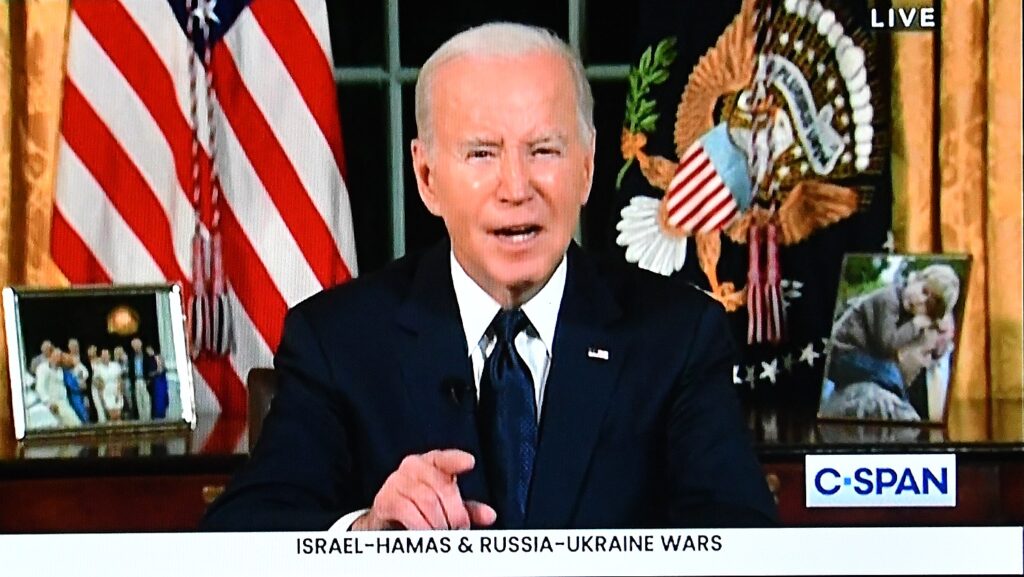“We can’t stand by and stand silent [in the wake of Antisemitic and Islamophobic incidents]. We must, without equivocation, denounce Antisemitism. We must also, without equivocation, denounce Islamophobia.” – President Biden

The Biden-Harris Administration is taking new actions and resources to address the alarming rise of reported Antisemitic and Islamophobic incidents at schools and on college campuses since the October 7th Hamas terrorist attacks in Israel. These actions will help protect students, engage school and university leaders, and foster safe and supportive learning environments.
The Justice Department (DOJ) has published an updated hate crimes threat response guide from the Federal Bureau of Investigation (FBI) to inform Americans about the steps they can take if they receive a threat. The guide, published on the FBI’s hate crimes resource page, has been shared with organizations and state and local law enforcement entities across the nation.
Actions the Department of Education (ED) is taking include:
- The National Center for Safe and Supportive Learning Environments, a technical assistance center funded by ED, is releasing two collections of specialized resources designed to help educators, students, parents, and community members prevent Antisemitism, Islamophobia, and related forms of discrimination – one for P-12 schools and the other for institutions of higher education.
- This week, senior ED leaders will host listening sessions with P-12 school leaders and university leaders to glean key insights from the field about how some schools are keeping students safe in the wake of the Israel-Hamas conflict. In addition, listening sessions with Jewish, Muslim, Arab, Palestinian, Sikh, and other students, educators, and staff are planned for the next few weeks. ED will share notable examples of ways schools and campuses can prevent and address Antisemitism and Islamophobia.
- Additionally, on December 6th, ED’s Office of Elementary and Secondary Education will launch a webinar series to develop, strengthen, and share evidence-informed strategies that help schools prevent and respond to hate-based threats, bullying, and harassment. The webinar series kicks off with a session on “Creating a Welcoming Environment” on Dec. 6, followed by webinars on “Full Student Participation” on Dec. 13, “Conflict Mediation” on Jan. 17, and “Ongoing Support” in February.
The United States Department of Agriculture (USDA) USDA is partnering with the Department of Education and Muslim and Jewish groups to host a webinar on November 16 on best practices for countering Antisemitism, Islamophobia, and other forms of hatred on rural college campuses.
Additional actions by the Biden-Harris Administration to combat Antisemitism and Islamophobia at schools and on college campuses include:
- The Departments of Homeland Security (DHS) and Justice (DOJ) have taken the following steps to increase campus safety:
- DHS and DOJ have disseminated public safety information to and hosted calls with campus law enforcement as part of broader outreach to state, local, tribal, and territorial officials to address the threat environment and share information about available resources. DHS has also shared relevant resources with campus partners nationwide. As part of its continued outreach to campuses, DHS’s Cybersecurity and Infrastructure Security Agency (CISA) is leveraging its 10 Regional field offices and their vast capabilities to conduct outreach and provide resources, tools, and services to K-12 and higher educational institutions to support their security requirements. On behalf of the U.S. Departments of Education, Health and Human Services, Homeland Security, and Justice, CISA continues to oversee the SchoolSafety.gov platform, which provides schools and districts with actionable recommendations to create safe and supportive environments for students and educators. The site serves as a one-stop access point for information, resources, guidance, and evidence-based practices on a range of school safety topics and threats. On Oct. 30, the DOJ announced that is awarding over $38 million in grants to support the investigation and prosecution of hate crimes, increase hate crimes reporting, expand victim services, and improve community awareness. This includes over $8 million in grants to community-based organizations and civil rights groups, including awards to organizations serving Jewish and Arab American communities.
- DOJ’s Community Relations Service continues to provide support on college campuses and remains in dialogue with Jewish, Muslim, Arab, and other impacted communities on college campuses nationwide.
- ED has taken a number of steps to address prohibited forms of Antisemitic and Islamophobic discrimination under Title VI of the Civil Rights Act of 1964 (Title VI).
- On Nov. 7, ED’s Office for Civil Rights (OCR) released a new Dear Colleague Letter reminding schools of their legal obligations under Title VI to provide all students, including students who are or are perceived to be Jewish, Israeli, Muslim, Arab, or Palestinian, a school environment free from discrimination based on race, color, or national origin. Secretary Cardona also has cautioned that if schools violate those obligations, ED has the authority to investigate and take action to redress violations, including by withholding federal dollars. As ED noted in the letter, the Department interprets its regulations consistent with the requirements of the First Amendment to the U.S. Constitution. Therefore, all of ED’s actions enforcing Title VI must comport with First Amendment principles, and ED’s regulations should not be interpreted to require recipients to enact or enforce codes that punish the exercise of protected free speech.
ED OCR also recently released an updated complaint form specifying that Title VI’s protection from discrimination based on race, color, or national origin extends to students who are or are perceived to be Jewish, Muslim, Hindu, or Sikh, or based on other shared ancestry or ethnic characteristics—making it easier for students and others who experience such discrimination to seek redress for it. ED additionally made clear that anyone who believes that a school has discriminated against a student based on race, color, or national origin may file a complaint of discrimination with ED OCR, and that the person who files the complaint need not have been the target of the alleged violation.
ED continues to offer technical assistance webinars to school communities as well as community organizations on these applications of Title VI. To request such a training, please contact ED OCR at [email protected].
- ED is sharing additional resources in this area, including a fact sheet, Protecting Students from Discrimination Based on Shared Ancestry or Ethnic Characteristics, which was released in January 2023, and a Dear Colleague Letter issued in May 2023 as part of the Department’s launch of the Antisemitism Awareness Campaign, announced under the U.S. National Strategy to Counter Antisemitism. These resources are available on the Shared Ancestry or Ethnic Characteristics page of ED OCR’s website.
- On Nov. 7, ED’s Office for Civil Rights (OCR) released a new Dear Colleague Letter reminding schools of their legal obligations under Title VI to provide all students, including students who are or are perceived to be Jewish, Israeli, Muslim, Arab, or Palestinian, a school environment free from discrimination based on race, color, or national origin. Secretary Cardona also has cautioned that if schools violate those obligations, ED has the authority to investigate and take action to redress violations, including by withholding federal dollars. As ED noted in the letter, the Department interprets its regulations consistent with the requirements of the First Amendment to the U.S. Constitution. Therefore, all of ED’s actions enforcing Title VI must comport with First Amendment principles, and ED’s regulations should not be interpreted to require recipients to enact or enforce codes that punish the exercise of protected free speech.
ED also continues to offer information about recently resolved complaints under Title VI, including complaints alleging discrimination based on shared ancestry or ethnic characteristics. That information is available here.
See also:




















